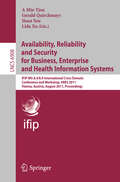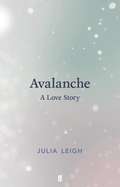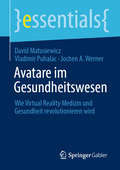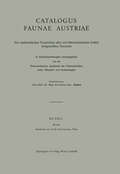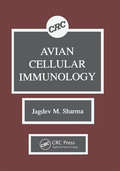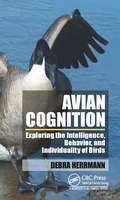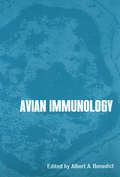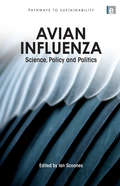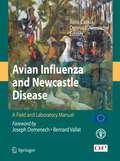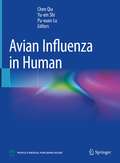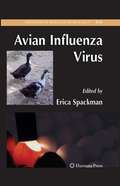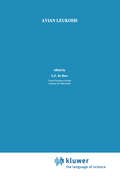- Table View
- List View
Autopsy Pathology: A Manual And Atlas
by Andrew J Connolly Walter E. Finkbeiner Philip C. Ursell Richard L. DavisA mainstay for pathology residents, Autopsy Pathology is designed with a uniquely combined manual and atlas format that presents today’s most complete coverage of performing, interpreting, and reporting post-mortem examinations. This lasting and useful medical reference book offers a practical, step-by-step approach to discussing not only the basics of the specialty, but the performance of specialized autopsy procedures as well.Material is divided into two sections for ease of use: a manual covering specific autopsy procedures, biosafety, generation of autopsy reports, preparation of death certificates, and other essential subjects; and an atlas, organized by organ system, which captures the appearance of the complete spectrum of autopsy findings.Covers forensic pathology in a chapter introducing the subspecialty.Offers expanded coverage of microscopic anatomy.Includes a chapter on performing special dissection procedures that may not be covered during a typical residency.Examines important techniques, such as autopsy photography and radiology, microscopic examination, supplemental laboratory studies, and other investigative approaches. Addresses the latest legal, social, and ethical issues relating to autopsies, as well as quality improvement and quality assurance.Presents more than 600 full-color photographs depicting common gross and microscopic autopsy findings for every part of the body. Correlates pathologic findings with their clinical causes to enhance diagnostic accuracy.Improved images in the Atlas section provide greater visual understanding.
Autopsy Pathology: A Manual And Atlas
by Walter E. Finkbeiner Andrew J Connolly Philip C. Ursell Richard L. DavisThis how-to guide presents today's most complete coverage of performing, interpreting, and reporting post-mortem examinations. In addition to discussing the basics of the specialty, this lasting and useful reference features information on the performance of specialized autopsy procedures. The material is divided into two sections for ease of use: a manual covering specific autopsy procedures, biosafety, generation of autopsy reports, preparation of death certificates, and other essential subjects; and an atlas, organized by organ system, that captures the appearance of the complete spectrum of autopsy findings. The updated second edition features a new chapter on the popular topic of forensic pathology.Focuses on hospital autopsy, while also providing a brief introduction to forensic autopsy. Examines autopsy photography and radiology, microscopic examination, supplemental laboratory studies, and other investigative approaches. Includes a chapter on performing special dissection procedures that are usually not covered during a typical residency. Presents over 590 full-color photographs depicting common gross and microscopic autopsy findings for every part of the body. Correlates pathologic findings with their clinical causes to enhance diagnostic accuracy.Covers the hot topic of forensic pathology in a new chapter introducing the subspecialty. Addresses the latest legal, social, and ethical issues as well as quality improvement and quality assurance. Features improved images in the Atlas section to give an even more useful visual reference.
Autoradiography
by John R.J. BakerThis book describes levels of autoradiography, which is the localization within a solid specimen of a radiolabel, to help the beginner or biologist choose the correct approach for particular application. It attempts to lay emphasis on certain aspects of the appraisal of autoradiographs.
Autoradiography
by John R.J. BakerThis book describes levels of autoradiography, which is the localization within a solid specimen of a radiolabel, to help the beginner or biologist choose the correct approach for particular application. It attempts to lay emphasis on certain aspects of the appraisal of autoradiographs.
Autotransfusion: Using your own blood
by K. MESSMERThe practice of autologous blood collection and transfusion has been steadily increasing. The concept is not new; however, its application has been limited because of lack of interest and willingness to make the extra effort required. Also there has been concern about the safety of the procedure. Homologous blood transfusion is easy and has allo wed us to salvage lives and perform procedures which would not have been feasible without the availability of whole blood or its components. Transfusion with homologous blood products is safe; however, com plications can and do occur. The transmission of AIDS by transfusion of homologous blood products has significantly increased patient and physician awareness of the dangers one faces. This potential complica tion has promoted autotransfusion. It is now commonly used and reques ted by patients and physicians. Blood for autotransfusion is collected pre or intraoperatively by phle botomy and retrieved intra and post operatively from sites of hemor rhage. Once collected, the blood is either stored or returned to the patient as whole or processed blood. To have a successful autotransfusion program requires anticipation of its needs and coordination and training of involved personel in the blood bank, emergency room, operating room and post-surgical care units. Pre deposit and processing of collected blood requires remission of donor criteria and labeling and storage procedures.
Autotrophic Microbiology and One-Carbon Metabolism: Volume I (Advances in Autotrophic Microbiology and One-Carbon Metabolism #1)
by G. A. Codd L. Dijkhuizen F. Robert TabitaAutotrophic and methylotrophic microorganisms are able to grow at the expense of one-carbon compounds (e.g. carbon dioxide, formaldehyde) as the principal carbon sources for the synthesis of cell material, using light, inorganic compounds or one-carbon compounds as energy sources. The study of the special adaptations required in aerobic and anaerobic microorganisms to sustain an autotrophic or methylotrophic mode of life is a fascinating field of research for scientists from various disciplines. Current research efforts not only focus on fundamental aspects, i.e. metabolic pathways and their regulation, ecology, energy conversion and genetics, but also the possible application of these organisms, in waste water treatment, degradation of xenobiotics, single-cell protein production, as biocatalysts for the production of fine chemicals, draws strong attention. The aim of this series is to provide annual reviews on the biochemistry, physiology, ecology, genetics, and application of microbial autotrophs and methylotrophs. The scope of the series includes all aspects of the biology of these microbes, and will deal with phototrophic and chemolithotrophic prokaryotic autotrophs, carboxydobacteria, acetogenic-, methanogenic- and methylotrophic bacteria, as well as methylotrophic eukaryotes. The exciting advances made in recent years in the study of these organisms is reflected in the chapters of this first volume which have been written by experts in the field. We would like to express our sincere thanks to all the contributors for their stimulating and comprehensive chapters.
AV-Shuntchirurgie: Der adäquate Gefäßzugang für die Hämodialyse
by Hans ScholzDie längere Lebenserwartung von Dialysepatienten und die Zunahme von Diabeteserkrankungen führen dazu, dass Shuntoperationen öfter und häufig wiederholt durchgeführt werden müssen. Ausgehend von seiner langjährigen klinischen und wissenschaftlichen Arbeit auf dem Gebiet der Shuntchirurgie beantwortet der Autor Fragen zur Auswahl des individuell sinnvollsten Eingriffs und zur Beherrschung von Komplikationen. Der Band enthält über 300 detaillierte Zeichnungen zum Prinzip der einzelnen Eingriffe und zum operativen Vorgehen.
Availability, Reliability and Security for Business, Enterprise and Health Information Systems: IFIP WG 8.4/8.9 International Cross Domain Conference and Workshop, Vienna, Austria, August 22-26, 2011, Proceedings (Lecture Notes in Computer Science #6908)
by A. Min Tjoa Gerald Quirchmayr Ilsun You Lida XuThis book constitutes the refereed proceedings of the IFIP WG 8.4/8.9 International Cross Domain Conference and Workshop on Availability, Reliability and Security - Multidisciplinary Research and Practice for Business, Enterprise and Health Information Systems, ARGES 2011, held in Vienna, Austria, in August 2011.The 29 revised papers presented were carefully reviewed and selected for inclusion in the volume. The papers concentrate on the many aspects of availability, reliability and security for information systems as a discipline bridging the application fields and the well-defined computer science field. They are organized in three sections: multidisciplinary research and practice for business, enterprise and health information systems; massive information sharing and integration and electronic healthcare; and papers from the colocated International Workshop on Security and Cognitive Informatics for Homeland Defense.
Avalanche: A Love Story
by Julia LeighAt the age of thirty-eight, acclaimed novelist Julia Leigh made her first visit to the IVF clinic, full of hope. So started a long and costly journey of nightly injections, blood tests, surgeries, and rituals.Writing in the immediate aftermath of her decision to stop treatment, Leigh lays bare the truths of her experience: the highs of hope and the depths of disappointment, the grip of yearning and desire, the toll on her relationships, and the unexpected graces and moments of black humour. Along the way she navigates the science of IVF, copes with the impact of treatment, and reconciles the seductive promises of the worldwide multi-billion-dollar IVF industry with the reality.Avalanche is the book that's finally been written on IVF treatment: a courageous, compelling, and ultimately wise account of a profoundly important and widespread experience. At the heart of this work is an exploration of who and how we love. It is a story we can all relate to - about the dreams we have, defeated or otherwise, for ourselves, our loves, and our relationships.Avalanche bears witness to Leigh's raw desire, suffering, strength, and, in the end, transformation, and her shift to a different kind of love.
Avascular Necrosis of the Femoral Head: Current Trends
by AnnaritaPiccinato NicolaSantori Francesco SaverioSantoriAvascular Necrosis (AVN) is a disease resulting from temporary or permanent loss of blood supply. It frequently affects the femoral head and in this area, if left untreated, routinely causes premature joint destruction. In the USA, 5 to 10% of cases of hip osteoarthritis requiring total hip replacement are primarily caused by AVN. In 33 to 72% of patients, the disease is bilateral. The peak incidence is between 30 and 60 years of age, and the social costs of this pathology are remarkable. There is therefore increasing interest in hip joint preserving techniques such as conservative treatment through electromagnetic fields and shockwaves as well as joint preserving surgical techniques. This volume aims to present a complete overview of the current knowledge on AVN including therapeutic options.
Avatare im Gesundheitswesen: Wie Virtual Reality Medizin und Gesundheit revolutionieren wird (essentials)
by David Matusiewicz Vladimir Puhalac Jochen A. WernerIn Zukunft werden wir mit unserem eigenen Avatar mit dem behandelnden Arzt im Smart Hospital sprechen können – und das vom Wohnzimmer aus. Das klingt utopisch, ist allerdings schon Realität geworden. Das essential beschäftigt sich mit der Frage, welchen Effekt Virtual Reality und die Avatare im Gesundheitswesen, der Medizin und in der Psychologie haben werden. Durch die praktische Erfahrung der Autoren können tiefgreifende Einblicke in eine exponentielle Technologie gegeben werden.
Avery's Diseases of the Newborn E-Book
by Christine A. Gleason Sherin DevaskarAvery’s Diseases of the Newborn, edited by Christine A. Gleason and Sherin U. Devaskar, is a practical, clinical reference for diagnosing and managing of all the important diseases affecting newborns. Thoroughly revised by a team of new editors, this edition provides new perspectives and updated coverage of genetics, nutrition, respiratory conditions, MRSA, neonatal pain, cardiovascular fetal interventions, care of the late preterm infant, and more. This authoritative reference is ideal as a clinical resource or subspecialty review tool. Treat newborns effectively with focused coverage of diagnosis and management, including pertinent developmental physiology and the pathogenesis of neonatal problems. Meet every challenge you face in neonatology with Avery’s authoritative, comprehensive clinical resource and subspecialty review tool. Navigate quickly and easily with extensive cross-referencing throughout the organ-related sections. Stay current with coverage of hot topics including MRSA, neonatal pain, cardiovascular fetal interventions, care of the late preterm infant, and the developing intestinal microbiome. Tap into the fresh perspectives of new editors who provide extensive updates throughout, particularly on genetic and respiratory disorders. Apply the latest nutritional findings with thorough discussions of this valuable information in the more comprehensive nutrition section. Master the fundamentals of neonatology through the greater emphasis on developmental biology and pathobiology.
Avery's Diseases of the Newborn E-Book: Expert Consult - Online And Print
by Christine A. Gleason Sandra E JuulCovering the evaluation and management of every key disease and condition affecting newborns, Avery’s Diseases of the Newborn, by Drs. Christine A. Gleason and Sandra E. Juul, remains your #1 source for practical, clinically relevant information in this fast-changing field. You’ll find the specific strategies you need to confidently diagnose and treat this unique patient population, in a full-color, easy-to-use single volume that focuses on key areas of practice. Now in a thoroughly revised 10th Edition, this highly respected reference is an authoritative clinical resource for neonatal practitioners.Provides up-to-date information on every aspect of newborn evaluation and management in a new, visually improved format featuring more than 500 all-new, full-color illustrations integrated within each chapter. Includes greatly expanded Neurology and Hematology sections that highlight the knowledge and expertise of new co-editor, Dr. Sandra E. Juul. Features all-new chapters on Palliative Care, Gastroesophageal Reflux, Platelet Disorders, Transfusion Therapy, Hypertension, , and The Ear and Hearing Disorders, as well as expanded coverage of brain injury and neuroprotective strategies in the preterm and term infant. Contains new Key Points boxes at the beginning of every chapter. Brings you up to date on current topics such as the evolving epidemic of neonatal abstinence syndrome and the new clinical uses of ultrasound.
Avery's Neonatology Board Review E-Book: Certification and Clinical Refresher
by Patricia ChessPrepare for success on the neonatology boards and in clinical practice with Avery’s Neonatology Board Review: Certification and Clinical Refresher. This highly practical review tool follows the exam blueprint, is based on the trusted content found in Avery’s Diseases of the Newborn, and has been carefully tailored for effective exam review by renowned neonatologist and educator, Patricia Chess, MD. Concise, relevant information is presented in a way that’s easy to study and remember, giving you an important advantage on this challenging exam, as well as in the daily, fast-changing practice of neonatology.Equips residents, fellows, and physicians with an efficient, comprehensive system for study, designed specifically to help you perform at your best on the board exam.Presents information in a high-yield, outline format highlighted by key points, graphs, tables, images, and algorithms.Over 300 questions onlineFeatures board-style vignettes in every chapter with full, discursive answers online.Written by experts in the field of Neonatal-Perinatal Medicine, representing a wealth of trusted insight and guidance.
Avian Cellular Immunology
by JagdevM. SharmaKnowledge regarding avian cellular immunity has expanded rapidly within the last few years and new information continues to accumulate. It is now a well-established fact that cell-mediated immunity plays a major role in the defense against neoplastic and non-neoplastic diseases in chickens. The principle objective of Avian Cellular Immunology is to compile the latest information available on various aspects of avian cellular immunity. The book contains chapters written by leading experts in the field and covers topics including cell surface markers, T-cell immunity, natural immune functions, the role of macrophages in cellular immune functions, cellular immune suppression and tolerance, cellular immune systems in avian species other than chickens, the role of cellular immunity in neoplastic and non-neoplastic viral diseases, cell-mediated immune mechanisms in bacterial and parasitic infections, and autoimmune disorders.
Avian Cellular Immunology
by JagdevM. SharmaKnowledge regarding avian cellular immunity has expanded rapidly within the last few years and new information continues to accumulate. It is now a well-established fact that cell-mediated immunity plays a major role in the defense against neoplastic and non-neoplastic diseases in chickens. The principle objective of Avian Cellular Immunology is to compile the latest information available on various aspects of avian cellular immunity. The book contains chapters written by leading experts in the field and covers topics including cell surface markers, T-cell immunity, natural immune functions, the role of macrophages in cellular immune functions, cellular immune suppression and tolerance, cellular immune systems in avian species other than chickens, the role of cellular immunity in neoplastic and non-neoplastic viral diseases, cell-mediated immune mechanisms in bacterial and parasitic infections, and autoimmune disorders.
Avian Cognition: Exploring the Intelligence, Behavior, and Individuality of Birds
by Debra S. HerrmannUnlike any other book, Avian Cognition thoroughly examines avian intelligence, behavior, and individuality. Preferences, choices, motivation, and habits of species, flocks, and individual birds are discussed and compared. This book investigates who birds are and why they do what they do. Daily, seasonal, and play activities, creativity, reasoning a
Avian Immunology (Advances in Experimental Medicine and Biology #88)
by A. BenedictThe ontogeny of lymphoid cells seems the most appropriate place to start. The early events in T and B cell ontogeny are still confusing. There seems to be no agreement on the data and on the semantics of the question of progenitor vs. stem cells. Nevertheless, we are beginning to understand more about progenitor cells which are committed to particular cell lines, and about stem cells in the sense of having almost unlimited capability of giving rise to undifferentiated progeny. An important future development will be to determine the nature of the substances that attract stem cells and which are produced by specialized thymus epithelium, and perhaps by the bursa. The way stem cells recognize these signals is an important question to answer. Not predictable from mammalian models has been the observation that there is a lack of cells called into the bursa even before the signal for entry of stem cells has been shut off. A likely model suggested that after a certain point in development there were no longer any cells capable of migrating into the bursa and becoming B cells. A fascinating possibility is the suggestion that a cell comes into the bursa, is not committed, then can still wander into the thymus. This cell does not appear to have B cell characteris tics; that is, immunoglobulin is not expressed on its surface.
Avian Influenza: "Science, Policy and Politics"
by Ian ScoonesOver the past decade, substantial resources have been spent on tackling avian influenza and building a global capacity for a pandemic response. The catastrophic costs of the 1918 influenza pandemic are well documented, and the swine flu pandemic of 2009-10 has raised the alarm yet again. Across the world, surveillance systems have been upgraded, stockpiles of antiviral drugs and influenza vaccines have been created, veterinary and public health systems have been improved and poultry production and marketing has been dramatically restructured. What are the lessons from this experience? And what does this suggest for the future? This book explores how virus genetics, ecology and epidemiology intersect with economic, political and policy processes in a variety of places - from Bangkok to Washington, to Jakarta, Cairo, Rome and London. It focuses on the interaction of the international and national responses - and in particular the experiences of Cambodia, Vietnam, Indonesia and Thailand. It asks how effective is the disease surveillance and response system - can it respond to a new pandemic threat? The comparative analysis reveals the challenges and limitations of a technocratic, centralised response, and the need to take seriously local contexts. Drawing from these experiences, the book concludes with a discussion of future prospects and challenges, examining in particular what a 'One World, One Health' approach - where approaches to animal, human and ecosystem health are integrated - would look like in practice. Published in association with the Economic and Social Research Council (ESRC)
Avian Influenza: "Science, Policy and Politics"
by Ian ScoonesOver the past decade, substantial resources have been spent on tackling avian influenza and building a global capacity for a pandemic response. The catastrophic costs of the 1918 influenza pandemic are well documented, and the swine flu pandemic of 2009-10 has raised the alarm yet again. Across the world, surveillance systems have been upgraded, stockpiles of antiviral drugs and influenza vaccines have been created, veterinary and public health systems have been improved and poultry production and marketing has been dramatically restructured. What are the lessons from this experience? And what does this suggest for the future? This book explores how virus genetics, ecology and epidemiology intersect with economic, political and policy processes in a variety of places - from Bangkok to Washington, to Jakarta, Cairo, Rome and London. It focuses on the interaction of the international and national responses - and in particular the experiences of Cambodia, Vietnam, Indonesia and Thailand. It asks how effective is the disease surveillance and response system - can it respond to a new pandemic threat? The comparative analysis reveals the challenges and limitations of a technocratic, centralised response, and the need to take seriously local contexts. Drawing from these experiences, the book concludes with a discussion of future prospects and challenges, examining in particular what a 'One World, One Health' approach - where approaches to animal, human and ecosystem health are integrated - would look like in practice. Published in association with the Economic and Social Research Council (ESRC)
Avian Influenza and Newcastle Disease: A Field and Laboratory Manual
by Illaria Capua Dennis J. AlexanderAvian Influenza (AI) and Newcastle Disease (ND) are two devastating diseases of poultry, which cause losses to the poultry industry and influence the liveability of rural communities worldwide. Following the H5N1 epidemic they appear to be endemic at least in Asia, Eastern Europe, The Middle East and Africa. Particularly in case of AI outbreaks it is essential that infection is diagnosed promptly and that isolates are made available to the international scientific community.Currently, several organisations including OIE, FAO and the EC have organised training courses in affected areas. However, often these courses do not cover all aspects of AI/ND diagnosis but only certain aspects. This results in fragmented areas of knowledge and in the application of different diagnostic protocols in different parts of the world. The objective of this book is to provide a comprehensive approach to AI diagnosis ranging from the clinical elements that should trigger a suspicion in the field, to the post mortem technique, collection of samples, processing/ shipment of specimens, virological, serological and molecular diagnosis and guidelines for notification.
Avian Influenza in Human
by Pu-Xuan Lu Chen Qiu Yu-Xin ShiSome avian influenza viruses can infect humans, cause disease, and even result in deaths. This book comprehensively and systematically presents the theory, diagnosis and clinical treatment of typical avian influenza viruses in human. The first chapters introduce the ethiology, epidemiology, clinical diagnosis and treatment of human avian influenza and complications. The following chapters include overview, extensive images, differential diagnosis and clinical cases of H7N9, H5N1, H5N6, H10N8, H9N2 and H7N4 avian influenza. Written by practitioners directly involved in the prevention and clinical treatment of human avian influenza, it will be an invaluable aid for practitioners in centers for infectious disease control and prevention, hospitals, and academic institutions to improve prevention, diagnosis and treatment of avian influenza in human.
Avian Influenza Virus (Methods in Molecular Biology #436)
by Erica SpackmanWith the growing global fear of a major pandemic, avian influenza (AI) virus research has greatly increased in importance. In Avian Influenza Virus, an expert team of researchers and diagnosticians examine the fundamental, yet essential, virological methods for AI virus research and diagnostics as well as some of the newest molecular procedures currently used for basic and applied research. They present exciting, cutting-edge new methods that focus both on studying the virus itself and on work with avian hosts, an area greatly lacking in research.
Avian Leukosis (Developments in Veterinary Virology #4)
by G. F. BoerThe intention of the series Developments in Veterinary Virology is to provide monographs dealing with the major animal viral diseases. Each volume will include the latest achievements in fundamental research and practical applications and should be readable for people from various disciplines and different backgrounds. The multi-author approach provides the best opportunity to keep each chapter at the highest level and makes the composition of the volumes manageable to the editors. This monograph on Avian Leukosis presents comprehensive reviews on the recent history of avian retrovirus research, on epizootiological, virological, pathological aspects, on tumor induction, the immune response to avian retro viruses, virus-cell interactions and on techniques for diagnosis. The volume deals mainly with exogenous avian leukosis virus (ALV) infections, but one chapter is entirely devoted to endogenous avian leukemia virus. Molecular biology aspects are confined to various oncogenes and to lymphoma induction since retroviruses, including those specific for avian species, have recently been described in detail in the Cold Spring Harbor Laboratory series "Molecular Biology of Tumor Viruses". Two chapters are devoted to the practical application of insights obtained from avian leukosis research: influences of AL V infection on production performance and eradication procedures.






